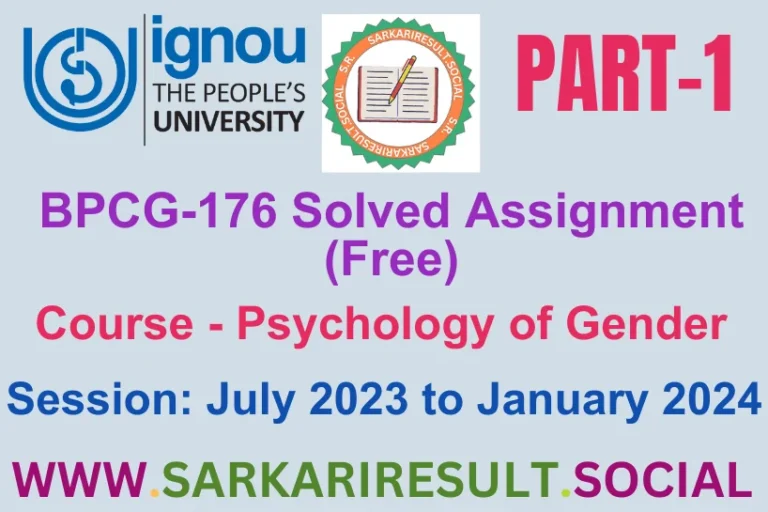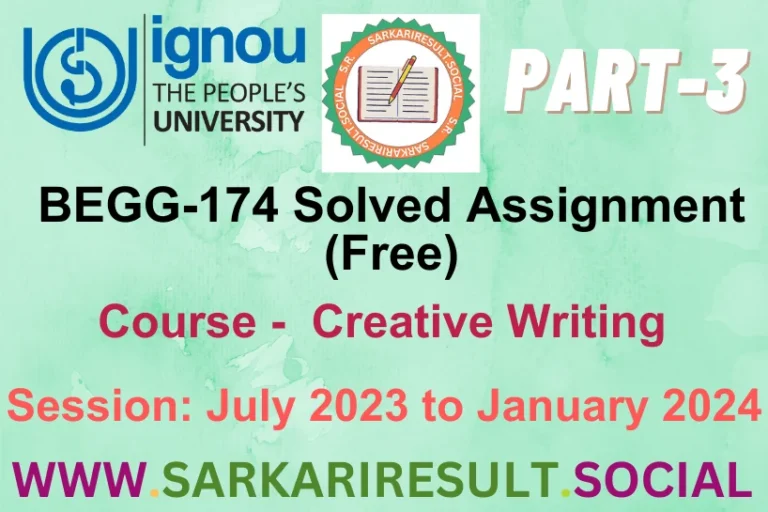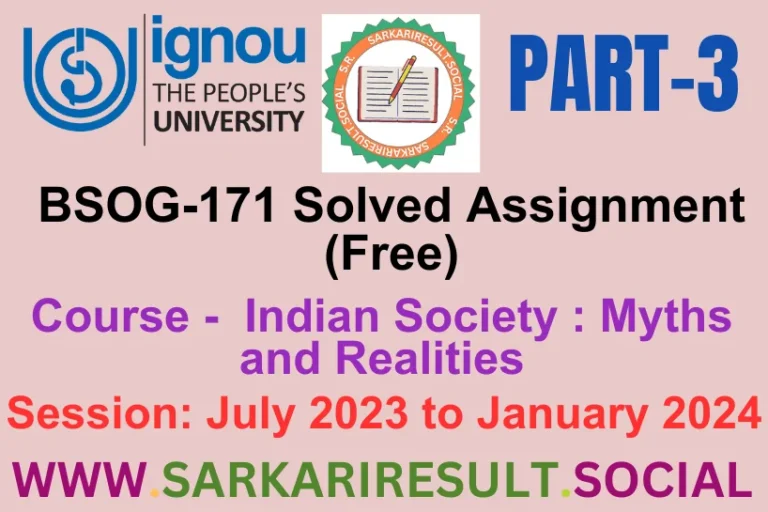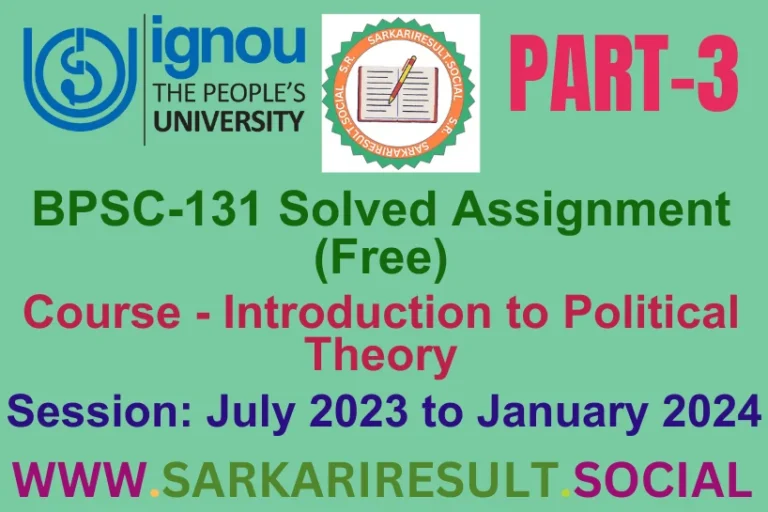BANC-133 IGNOU Solved Assignment 2023-24 (free) Part 1

BANC-133 IGNOU Solved Assignment 2023-24 (free) Part 1
“Embark on an enlightening journey through the realm of Social and Cultural Anthropology with Solved BANC-133 IGNOU Solved Assignment 2023-24 (free) Part 1. In this Assignment – A, you’ll get two comprehensive questions, answered in approximately 500 words each. These answers, covering key aspects of the field, will guide you toward success in your IGNOU solved assignments for 2023-24.

a. Define the social and cultural anthropology. Discuss its scope.
Ans. Social and cultural anthropology is a subfield of anthropology that focuses on the study of human societies, cultures, and behaviors. It seeks to understand the diversity of human cultures, their social structures, belief systems, and practices. This discipline employs various research methods, including participant observation, interviews, and ethnographic research, to gain insights into the intricacies of human societies. In this discussion, we will delve into the scope of social and cultural anthropology in approximately 500 words.
The scope of social and cultural anthropology is vast and encompasses a wide range of topics and areas of study. At its core, this field seeks to answer fundamental questions about human existence, societies, and cultures. Here are some key aspects of its scope:
1. Cultural Variation: One of the primary concerns of cultural anthropology is the exploration of cultural diversity. Anthropologists study how different cultures vary in terms of customs, traditions, language, religion, kinship systems, and more. This involves both understanding the unique aspects of each culture and identifying commonalities among them.
2. Cultural Change: Anthropologists also investigate how cultures change and adapt over time. This includes examining the impact of globalization, technology, migration, and other factors on traditional cultures. They explore how societies incorporate new elements while preserving their cultural identity.
BANC-132 Solved Assignment 2023-24 (free) Part 1
3. Social Organization: Social anthropology focuses on the structure and organization of human societies. Anthropologists examine kinship systems, social hierarchies, gender roles, and power dynamics within different cultures. This helps in understanding how societies maintain order and cohesion.
4. Economic Systems: The study of economic systems is another crucial aspect of social and cultural anthropology. This involves analyzing modes of production, distribution, and consumption within societies. Anthropologists investigate subsistence strategies, trade networks, and the economic activities of different groups.
5. Religion and Belief Systems: Cultural anthropology delves into the spiritual and religious beliefs of societies. Researchers explore rituals, mythologies, and the role of religion in shaping cultural values and behaviors. They also examine how religious practices evolve and adapt.
6. Language and Communication: Linguistic anthropology is a subfield that focuses on the study of language and communication within cultures. Anthropologists analyze language structures, dialects, and the role of language in shaping cultural identities.
BANC-132 Solved Assignment 2023-24 (free) Part 2
7. Political Systems: Political anthropology investigates how power and governance function in different societies. Researchers examine political structures, leadership, decision-making processes, and conflicts within and between groups.
8. Applied Anthropology: Beyond academic research, anthropology has practical applications in areas such as development, healthcare, and advocacy. Applied anthropologists work on projects related to public health, cultural preservation, social justice, and more, applying anthropological insights to real-world issues.
9. Ethnographic Research: Ethnography is a hallmark of cultural anthropology. Anthropologists conduct immersive fieldwork, living among the people they study to gain a deep understanding of their culture. This involves participant observation, interviews, and the collection of rich qualitative data.
10. Cross-Cultural Comparisons: Anthropologists often engage in cross-cultural comparisons to identify patterns and trends in human behavior and culture. These comparisons help in developing theories about human nature and cultural universals.
In summary, social and cultural anthropology is a multidisciplinary field that explores the richness and complexity of human societies and cultures. Its scope encompasses the study of cultural diversity, change, social organization, economic systems, religion, language, politics, and more. Moreover, it has practical applications in addressing contemporary societal challenges. Through ethnographic research and cross-cultural comparisons, anthropologists contribute valuable insights into our understanding of what it means to be human and how societies function and evolve.
BANC-132 Solved Assignment 2023-24 (free) Part 3
b. Deliberate on the economic, political and religious institutions in societies.
Ans. Economic, political, and religious institutions constitute the cornerstones of human societies, each playing a distinct and indispensable role in shaping the fabric of civilization. In the ensuing discussion, I shall expound upon the nature, functions, and interplay of these institutions, adhering to the prescribed limit of 500 words, in a manner befitting the formality of the topic.
Economic Institutions:
Economic institutions serve as the underpinning structures regulating the production, allocation, and consumption of resources and goods within a society. They encompass multifarious systems, embodying the modes of production, market mechanisms, property rights, and labor practices that characterize a given socioeconomic framework.
Modes of production, a foundational component of economic institutions, delineate how goods and services are generated. Traditional societies may rely on subsistence agriculture or hunting and gathering, while modern civilizations gravitate towards industrial or service-based production.
BANC-131 Solved Assignment 2023-24 (free) Part 1
Market systems, conversely, govern the allocation of resources. Some societies embrace market-oriented economies, where supply and demand dictate economic activities, while others adhere to centrally planned systems where government entities retain authority over vital industries and resource distribution.
Property rights, another vital facet of economic institutions, stipulate the parameters of ownership and resource management. Well-defined property rights are fundamental for fostering economic stability and growth.
Additionally, labor and employment practices are integral aspects. Economic institutions orchestrate labor laws, wages, and workers’ rights, exerting profound implications on social and political dynamics.
Political Institutions:
BANC-132 Solved Assignment 2023-24 (free) Part 2
Political institutions function as the custodians of governance, dictating the distribution of power, the configuration of decision-making mechanisms, and the perpetuation of social order within a society. These institutions range from democratic models, where elected representatives wield authority, to autocratic systems where power is centralized, thereby profoundly influencing resource allocation and the safeguarding of individual liberties.
Governance structures represent the fulcrum upon which political institutions pivot, determining the trajectory of societal organization. Democratic paradigms vest power in elected representatives, advocating transparency and public participation, while autocratic regimes may concentrate authority in a single leader or ruling entity.
The rule of law, a sacrosanct principle intrinsic to political institutions, ensures that all members of society, irrespective of their social standing, are held accountable to the same corpus of laws. This egalitarian underpinning forms the bedrock of a just and equitable society.
The protection and enforcement of rights and freedoms fall under the purview of political institutions, encompassing civil liberties such as freedom of speech, assembly, and religion, as well as safeguards against discrimination and arbitrary detention. Moreover, political institutions dictate foreign relations, presiding over diplomacy, international treaties, and the formulation of foreign policy.
Religious Institutions:
Religious institutions, in contrast, imbue societies with spiritual and moral guidance, offering belief systems that underpin ethical precepts and moral values. They encompass a mosaic of religious traditions, ranging from monotheistic religions like Christianity and Islam to polytheistic practices as seen in Hinduism.
BANC-132 Solved Assignment 2023-24 (free) Part 3
Places of worship hold an eminent place within religious institutions, serving as sanctuaries for communal devotion and religious rituals. These edifices engender a sense of belonging and facilitate the collective expression of faith.
Clergy and religious leadership constitute an integral facet, guiding the adherents of faith, officiating ceremonies, and interpreting sacred texts.
Religious practices, an essential component, encompass rituals, ceremonies, and religious customs that are pivotal in nurturing a sense of spirituality and moral duty. These practices vary widely, from prayer and meditation to fasting and pilgrimage, in accordance with the tenets of each respective faith.
In conclusion, economic, political, and religious institutions form the scaffolding upon which societies are erected. Economic institutions govern the material dimensions of life, political institutions regulate governance and civic life, and religious institutions offer spiritual and moral guidance. The synergy between these institutions shapes the intricate tapestry of civilizations, impacting culture, governance, and societal values. Profoundly understanding their roles is requisite for comprehending the manifold complexities that distinguish societies and their historical trajectories.







